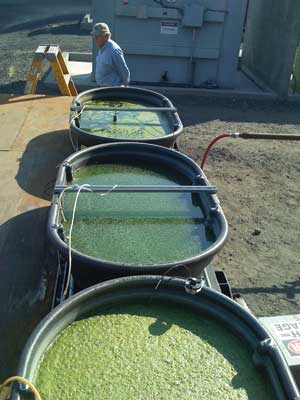Carbon dioxide emissions could spur algae growth

November 13, 2008
BY Kris Bevill
The northwest portion of the United States isn't rife with cropland suitable for soybeans or other feedstocks ideal for biodiesel production, so industry members there have been more resourceful in their attempts to produce biodiesel. In Oregon, an algae-based project is underway that could ultimately serve as an example for industrial partnerships throughout the country.
Two years ago, Jon Norling, vice president of Washington-based renewable energy company Columbia Energy Partners LLC, began exploring an idea to produce biodiesel from algal oil generated by feeding algae carbon dioxide emissions from a coal-fired power plant. Norling also serves as president of Portland Biodiesel LLC, a 1 MMgy biodiesel plant in Portland, Ore. Columbia Energy Partners agreed the project was a good idea, and Norling began seeking a partner.
Portland General Electric proved to be the ideal choice. The electric utility operates the only coal-fired electricity plant in Oregon and is a fairly progressive company, according to Norling. Its 600-megawatt facility is located in a part of the state conducive to algae growth and encompassed by a large amount of open space-a crucial element as Norling anticipates ultimately needing 7,500 acres of open air algae ponds for commercial production. The company agreed to give the concept a try, and preliminary work began earlier this year.
At press time, Columbia Energy Partners was conducting a feasibility study to determine if algae can feed on the carbon dioxide emitted from the power plant and what amounts of carbon dioxide-and potentially other greenhouse gases-the algae can consume. Seattle-based BioAlgene LLC is providing the algae strains for this portion of the project, according to Norling. "If the results of the first phase are positive, we'll move into the second phase, which will be the construction of larger, in-the-ground test ponds," he said. The company will also then begin work on some of the engineering details.
Norling said the project is taking baby steps at Portland General Electric's request. He expects a commercial-scale project to be three to five years away. "There are some major issues," he said, noting the difficulties of keeping open-air algae ponds free from contamination, and the actual process of squeezing oil from the algae.
The concept has the potential to offer other carbon dioxide emitters a way to reduce their output of greenhouse gases. Norling said the process can be applied to any industrial facility, provided it's surrounded by a fair amount of land and sunlight.
Two years ago, Jon Norling, vice president of Washington-based renewable energy company Columbia Energy Partners LLC, began exploring an idea to produce biodiesel from algal oil generated by feeding algae carbon dioxide emissions from a coal-fired power plant. Norling also serves as president of Portland Biodiesel LLC, a 1 MMgy biodiesel plant in Portland, Ore. Columbia Energy Partners agreed the project was a good idea, and Norling began seeking a partner.
Portland General Electric proved to be the ideal choice. The electric utility operates the only coal-fired electricity plant in Oregon and is a fairly progressive company, according to Norling. Its 600-megawatt facility is located in a part of the state conducive to algae growth and encompassed by a large amount of open space-a crucial element as Norling anticipates ultimately needing 7,500 acres of open air algae ponds for commercial production. The company agreed to give the concept a try, and preliminary work began earlier this year.
At press time, Columbia Energy Partners was conducting a feasibility study to determine if algae can feed on the carbon dioxide emitted from the power plant and what amounts of carbon dioxide-and potentially other greenhouse gases-the algae can consume. Seattle-based BioAlgene LLC is providing the algae strains for this portion of the project, according to Norling. "If the results of the first phase are positive, we'll move into the second phase, which will be the construction of larger, in-the-ground test ponds," he said. The company will also then begin work on some of the engineering details.
Norling said the project is taking baby steps at Portland General Electric's request. He expects a commercial-scale project to be three to five years away. "There are some major issues," he said, noting the difficulties of keeping open-air algae ponds free from contamination, and the actual process of squeezing oil from the algae.
The concept has the potential to offer other carbon dioxide emitters a way to reduce their output of greenhouse gases. Norling said the process can be applied to any industrial facility, provided it's surrounded by a fair amount of land and sunlight.
Advertisement
Advertisement
Upcoming Events





